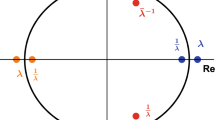Abstract
This paper analyzes energy equipartition in linear Hamiltonian systems in a deterministic setting. We consider the group of phase space symmetries of a stable linear Hamiltonian system, and characterize the subgroup of symmetries whose elements preserve the time averages of quadratic functions along the trajectories of the system. As a corollary, we show that if the system has simple eigenvalues, then every symmetry preserves averages of quadratic functions. As an application of our results to linear undamped lumped-parameter systems, we provide a novel proof of the virial theorem, which states that the total energy is equipartitioned on the average between the kinetic energy and the potential energy. We also show that under the assumption of distinct natural frequencies, the time-averaged energies of two identical substructures of a linear undamped structure are equal. Examples are provided to illustrate the results.
Similar content being viewed by others
References
Abraham R, Marsden JE (1978) Foundations of mechanics. Addison-Wesley, Reading
Anderson BDO (1980) Nonlinear networks and Onsager–Casimir reversibility. IEEE Trans Circuits Syst 27: 1051–1058
Arnold VI (1989) Mathematical methods of classical mechanics, 2nd edn. Springer, New York
Barahona M, Doherty AC, Sznaier M, Mabuchi H, Doyle JC (2002) Finite horizon model reduction and the appearance of dissipation in Hamiltonian systems. In: Proceedings of the IEEE conference on decision and control. Las Vegas, NV, pp 4563–4568
Bernstein DS (2005) Matrix mathematics. Princeton University Press, Princeton
Bernstein DS, Bhat SP (1995) Lyapunov stability, semistability, and asymptotic stability of matrix second-order systems. J Mech Des Trans ASME 117: 145–153
Bernstein DS, Bhat SP (2002) Energy equipartition and the emergence of damping in lossless systems. In: Proceedings of the IEEE conference on decision and control. December, Las Vegas, NV, pp 2913–2918
Brockett RW, Willems JC (1978) Stochastic control and the second law of thermodynamics. In: Proceedings of the IEEE conference on decision and control. San Diego, CA, pp 1007–1011
Brush SG (1976) The kind of motion we call heat: a history of the kinetic theory in the nineteenth century. Amsterdam , North Holland
Chellaboina V-S, Haddad WM, Nersesov SG (2005) Thermodynamics: a dynamical systems approach. Princeton series in applied mathematics. Princeton University Press, Princeton
Goldstein H (1980) Classical mechanics, 2nd edn. Addison-Wesley, Reading
Hartman P (1982) Ordinary differential equations, 2nd edn. Birkhäuser, Boston
Khinchin AI (1949) Mathematical foundations of statistical mechanics. Dover Publications, New York
Meyer KR, Hall GR (1992) Introduction to Hamiltonian dynamical systems and the N-body problem. Springer, New York
Onishchik, AL (eds) (1993) Lie groups and Lie Algebras I. Springer, Berlin
Rapisarda P, Willems JC (2005) Conserved- and zero-mean quadratic quantities in oscillatory systems. Math Control Signals Syst 17(3): 173–200
Ruelle D (1969) Statistical mechanics: rigorous results. The mathematical physics monographs series. W. A. Benjamin, New York
Sandberg H, Delvenne J-C, Doyle JC (2007) The statistical mechanics of fluctuation–dissipation and measurement back action. In: Proceedings of the American control conference. July, New York, NY, pp 1033–1038
Tolman RC (1979) The principles of statistical mechanics. Dover Publications, New York
Truesdell C (1980) The tragicomical history of thermodynamics, 1822–1854. Springer, New York
Willems JC (1972) Dissipative dynamical systems part I: General theory. Arch Ration Mech Anal 45: 321–351
Willems JC (1972) Dissipative dynamical systems part II: Linear systems with quadratic supply rates. Arch Ration Mech Anal 45: 352–393
Author information
Authors and Affiliations
Corresponding author
Additional information
A preliminary version of the results of this paper appeared in the proceedings of the IEEE Conference on Decision and Control, 2004.
Rights and permissions
About this article
Cite this article
Bhat, S.P., Bernstein, D.S. Average-preserving symmetries and energy equipartition in linear Hamiltonian systems. Math. Control Signals Syst. 21, 127–146 (2009). https://doi.org/10.1007/s00498-009-0039-2
Received:
Accepted:
Published:
Issue Date:
DOI: https://doi.org/10.1007/s00498-009-0039-2



